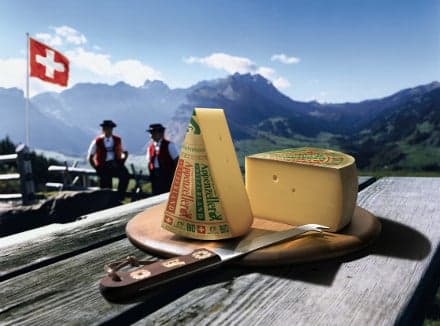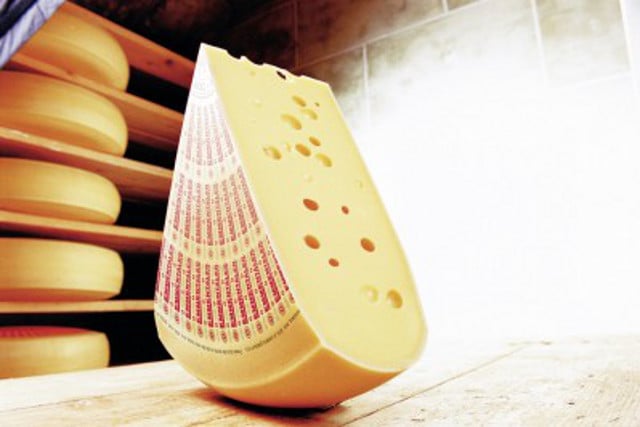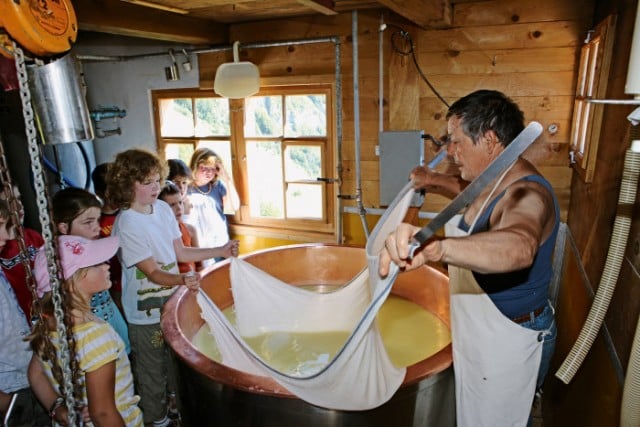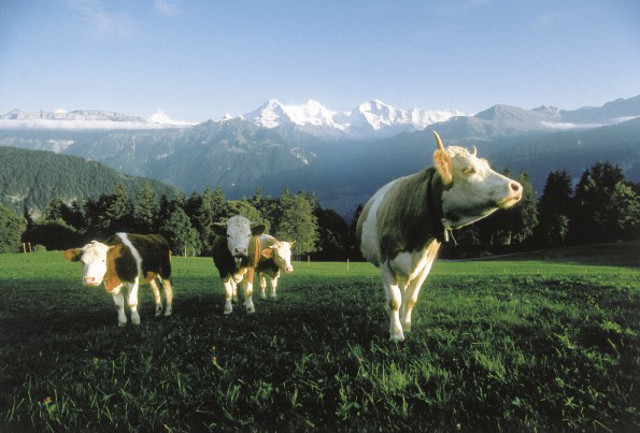15 facts you may not have known about Swiss cheese

The ultimate symbol of Swissness, cheese is a venerated commodity in Switzerland. The Local looks at the facts behind the Swiss cheese industry.
1. According to industry figures, in 2016 some 186,756 tons of cheese was eaten in Switzerland, that’s just over 22kg per person, 560g more than the previous year.
2. While the Swiss are undoubtedly big cheese fans, they don’t eat as much as some other countries, including Germany, Cyprus, Iceland, Denmark and Finland who all surpass Switzerland for per capita cheese consumption. Unsurprisingly, the French are world cheese-eating champions, munching through 26.8kg per person every year according to 2015 figures.
3. There are more than 450 varieties of Swiss cheese, and nearly half the milk produced in Switzerland is turned into cheese.
4. The top-produced variety of Swiss cheese is Le Gruyère, of which more than 28,500 tons was produced in 2015. Perhaps surprisingly, mozzarella is second, followed by Emmentaler, séré (the Swiss-French word for fromage frais) and Raclette.
 Emmentaler, with its distinctive holes, is a favourite. Photo: Switzerland Cheese Marketing.
5. The Swiss favour homegrown cheeses by far, however 31 percent of cheese consumed in the country in 2016 was imported. That's up from 23 percent ten years ago, partly because of the strong franc. Italian cheese is the most popular import, followed by French and German cheeses.
6. Around a third of Swiss cheese is exported. Emmentaler – the distinctive holey cheese also known as Emmental – is the most exported Swiss cheese, with Le Gruyère a close second.
7. According to industry body Switzerland Cheese Marketing, Emmentaler destined for exportation is produced according to national preferences. For example, the Italians are partial to plenty of holes in their Emmentaler, while the French prefer it sans trous. Who knew?
8. Germany is the biggest guzzler of Swiss cheese, receiving just under half of all Swiss cheese exports. Italy takes 16 percent, the US 13 percent and France seven percent.
9. In the past ten years fromage frais and soft and semi-soft cheeses have become increasingly popular, while sales of hard cheese have decreased slightly. Sheep and goats cheese have also grown in popularity.
10. Ten Swiss cheeses carry the AOP label (Appellation d’Origine Protégée), which means the product is entirely made in its region of origin. Among these are Emmentaler, Le Gruyère, L’Etivaz, Raclette de Valais, Tête de Moine and Vacherin Mont-d’Or. Another label, IGP (Indication Geographique Protégée) means that at least one step in the production process must have been carried out in the region of origin.
Emmentaler, with its distinctive holes, is a favourite. Photo: Switzerland Cheese Marketing.
5. The Swiss favour homegrown cheeses by far, however 31 percent of cheese consumed in the country in 2016 was imported. That's up from 23 percent ten years ago, partly because of the strong franc. Italian cheese is the most popular import, followed by French and German cheeses.
6. Around a third of Swiss cheese is exported. Emmentaler – the distinctive holey cheese also known as Emmental – is the most exported Swiss cheese, with Le Gruyère a close second.
7. According to industry body Switzerland Cheese Marketing, Emmentaler destined for exportation is produced according to national preferences. For example, the Italians are partial to plenty of holes in their Emmentaler, while the French prefer it sans trous. Who knew?
8. Germany is the biggest guzzler of Swiss cheese, receiving just under half of all Swiss cheese exports. Italy takes 16 percent, the US 13 percent and France seven percent.
9. In the past ten years fromage frais and soft and semi-soft cheeses have become increasingly popular, while sales of hard cheese have decreased slightly. Sheep and goats cheese have also grown in popularity.
10. Ten Swiss cheeses carry the AOP label (Appellation d’Origine Protégée), which means the product is entirely made in its region of origin. Among these are Emmentaler, Le Gruyère, L’Etivaz, Raclette de Valais, Tête de Moine and Vacherin Mont-d’Or. Another label, IGP (Indication Geographique Protégée) means that at least one step in the production process must have been carried out in the region of origin.
 Cheese-making, the traditional way. Photo: Swiss Tourism
11. Lactose intolerant? Some hard Swiss cheeses including Le Gruyère and Emmentaler don’t contain any lactose, since it’s broken down in the production process. Others, including Appenzeller and Raclette de Valais, contain low levels and are well tolerated by some lactose-intolerant people.
12. According to Switzerland Cheese Marketing the holes in Emmentaler are made by bacteria which transform the lactose into carbon dioxide and create air pockets. However a 2015 study by Swiss agriculture body Agroscope countered this, saying the holes were caused by tiny bits of hay present in the milk.
13. Many Swiss hard cheeses – such as Le Gruyère, Emmentaler, Sbrinz – are made with raw, unpasteurized milk since the enzymes and bacteria they contain produce flavours in the cheese that pasteurized milk cannot achieve, particularly in the maturation process. Pasteurized cheeses – such as mozzarella – therefore have a milder flavour and are typically eaten when 'young'.
14. Hard cheeses including Le Gruyère and Emmentaler are ready to eat after a minimum four months’ maturation period, achieving full maturity after seven to 12 months. Sbrinz is best eaten after two to three years of maturing in the cheese cellar.
15. If a cheese is marked fromage d’alpage/Alpkäse, it means it was produced directly on the mountain pastures in the summer months only. Many Swiss farmers take their cows up to the pastures in spring, and return them in the autumn. During the months of summer the cheese is made in the traditional manner on the pastures. This gives the cheese a character and flavour that’s particular to its region and the herbs and flowers that the cows have been munching on.
Cheese-making, the traditional way. Photo: Swiss Tourism
11. Lactose intolerant? Some hard Swiss cheeses including Le Gruyère and Emmentaler don’t contain any lactose, since it’s broken down in the production process. Others, including Appenzeller and Raclette de Valais, contain low levels and are well tolerated by some lactose-intolerant people.
12. According to Switzerland Cheese Marketing the holes in Emmentaler are made by bacteria which transform the lactose into carbon dioxide and create air pockets. However a 2015 study by Swiss agriculture body Agroscope countered this, saying the holes were caused by tiny bits of hay present in the milk.
13. Many Swiss hard cheeses – such as Le Gruyère, Emmentaler, Sbrinz – are made with raw, unpasteurized milk since the enzymes and bacteria they contain produce flavours in the cheese that pasteurized milk cannot achieve, particularly in the maturation process. Pasteurized cheeses – such as mozzarella – therefore have a milder flavour and are typically eaten when 'young'.
14. Hard cheeses including Le Gruyère and Emmentaler are ready to eat after a minimum four months’ maturation period, achieving full maturity after seven to 12 months. Sbrinz is best eaten after two to three years of maturing in the cheese cellar.
15. If a cheese is marked fromage d’alpage/Alpkäse, it means it was produced directly on the mountain pastures in the summer months only. Many Swiss farmers take their cows up to the pastures in spring, and return them in the autumn. During the months of summer the cheese is made in the traditional manner on the pastures. This gives the cheese a character and flavour that’s particular to its region and the herbs and flowers that the cows have been munching on.
 Happy cows on the alpine pastures in the summer. Photo: Switzerland Cheese Marketing
Happy cows on the alpine pastures in the summer. Photo: Switzerland Cheese Marketing
Comments
See Also
1. According to industry figures, in 2016 some 186,756 tons of cheese was eaten in Switzerland, that’s just over 22kg per person, 560g more than the previous year.
2. While the Swiss are undoubtedly big cheese fans, they don’t eat as much as some other countries, including Germany, Cyprus, Iceland, Denmark and Finland who all surpass Switzerland for per capita cheese consumption. Unsurprisingly, the French are world cheese-eating champions, munching through 26.8kg per person every year according to 2015 figures.
3. There are more than 450 varieties of Swiss cheese, and nearly half the milk produced in Switzerland is turned into cheese.
4. The top-produced variety of Swiss cheese is Le Gruyère, of which more than 28,500 tons was produced in 2015. Perhaps surprisingly, mozzarella is second, followed by Emmentaler, séré (the Swiss-French word for fromage frais) and Raclette.

Emmentaler, with its distinctive holes, is a favourite. Photo: Switzerland Cheese Marketing.
5. The Swiss favour homegrown cheeses by far, however 31 percent of cheese consumed in the country in 2016 was imported. That's up from 23 percent ten years ago, partly because of the strong franc. Italian cheese is the most popular import, followed by French and German cheeses.
6. Around a third of Swiss cheese is exported. Emmentaler – the distinctive holey cheese also known as Emmental – is the most exported Swiss cheese, with Le Gruyère a close second.
7. According to industry body Switzerland Cheese Marketing, Emmentaler destined for exportation is produced according to national preferences. For example, the Italians are partial to plenty of holes in their Emmentaler, while the French prefer it sans trous. Who knew?
8. Germany is the biggest guzzler of Swiss cheese, receiving just under half of all Swiss cheese exports. Italy takes 16 percent, the US 13 percent and France seven percent.
9. In the past ten years fromage frais and soft and semi-soft cheeses have become increasingly popular, while sales of hard cheese have decreased slightly. Sheep and goats cheese have also grown in popularity.
10. Ten Swiss cheeses carry the AOP label (Appellation d’Origine Protégée), which means the product is entirely made in its region of origin. Among these are Emmentaler, Le Gruyère, L’Etivaz, Raclette de Valais, Tête de Moine and Vacherin Mont-d’Or. Another label, IGP (Indication Geographique Protégée) means that at least one step in the production process must have been carried out in the region of origin.

Cheese-making, the traditional way. Photo: Swiss Tourism
11. Lactose intolerant? Some hard Swiss cheeses including Le Gruyère and Emmentaler don’t contain any lactose, since it’s broken down in the production process. Others, including Appenzeller and Raclette de Valais, contain low levels and are well tolerated by some lactose-intolerant people.
12. According to Switzerland Cheese Marketing the holes in Emmentaler are made by bacteria which transform the lactose into carbon dioxide and create air pockets. However a 2015 study by Swiss agriculture body Agroscope countered this, saying the holes were caused by tiny bits of hay present in the milk.
13. Many Swiss hard cheeses – such as Le Gruyère, Emmentaler, Sbrinz – are made with raw, unpasteurized milk since the enzymes and bacteria they contain produce flavours in the cheese that pasteurized milk cannot achieve, particularly in the maturation process. Pasteurized cheeses – such as mozzarella – therefore have a milder flavour and are typically eaten when 'young'.
14. Hard cheeses including Le Gruyère and Emmentaler are ready to eat after a minimum four months’ maturation period, achieving full maturity after seven to 12 months. Sbrinz is best eaten after two to three years of maturing in the cheese cellar.
15. If a cheese is marked fromage d’alpage/Alpkäse, it means it was produced directly on the mountain pastures in the summer months only. Many Swiss farmers take their cows up to the pastures in spring, and return them in the autumn. During the months of summer the cheese is made in the traditional manner on the pastures. This gives the cheese a character and flavour that’s particular to its region and the herbs and flowers that the cows have been munching on.

Happy cows on the alpine pastures in the summer. Photo: Switzerland Cheese Marketing
Join the conversation in our comments section below. Share your own views and experience and if you have a question or suggestion for our journalists then email us at [email protected].
Please keep comments civil, constructive and on topic – and make sure to read our terms of use before getting involved.
Please log in here to leave a comment.